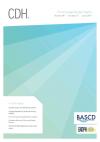Community Dental Health

- Cover Date:
- June 2017
- Print ISSN:
- 0265 539X
- Vol:
- 34
- Issue:
- 2
Socio-demographic and area-related factors associated with the prevalence of caries among preschool children in Greece.
Objective: To assess dental caries experience in 4-6 year old children of the Athens Metropolitan Area attending public kindergartens and investigate the association of area deprivation and immigration status on dmft. Basic research design: A cross-sectional study of a large area-stratified sample of 683 kindergarten children was conducted during the academic years 2009-2011. Dental caries experience and oral hygiene level were assessed using dmft and the Simplified Debris index (DI-s). Area deprivation was defined using a pre-established Geo-demographic System for Attica. Zero-inflated Poisson regression models were used to test associations between the dmft index and related factors; gender, age, immigrant background and area deprivation. Differences were reported in terms of predicted probabilities. Results: Caries prevalence was 20.8% (95% CI17.8,24.0%). The mean dmft and DI-s scores were 0.67 (95% CI0.61,0.74) and 0.16 (95% CI0.14,0.18) respectively. The mean predicted probability of having no detectable caries experience was 79% (95% CI75, 83%), while the probability of having dmft=1 or 2 was 6% (95% CI5,8%) and 2% (95% CI1,3%) respectively. The predicted probability of having no caries experience was substantially lower for males, those from the least affluent areas and non-Greeks by 5%, 18% and 31% respectively.
Regarding dmft scores, deprived children were more likely to have 1 or 2 teeth with caries experience by 9% (95% CI4,13%) and 6% (95% CI2,10%) respectively, while the corresponding differences for non-Greeks were 10% (95% CI7,14%) and 12% (95% CI7,15%). Conclusions: Socio-demographic and area-related variations in oral health exist among kindergarten children in Athens.
Key words: socio demographic factors, prevalence of dental caries, pre-school children, Greece
doi:10.1922/CDH_4034Mantonanaki06
- Article Price
- £15.00
- Institution Article Price
- £
- Page Start
- 112
- Page End
- 117
- Authors
- M. Mantonanaki, T. Hatzichristos, H. Koletsi-Kounari, W. Papaioannou
Articles from this issue
- Title
- Pg. Start
- Pg. End
- Communities in action: developing a dental ambassador training programme for adults with learning disability
- 77
- 79
- Public health intervention over four decades for the children in the Australian Capital Territory: Have we reached the point of diminishing returns?
- 84
- 87
- Relationship between mental health risk factors and oral symptoms in adolescents: Korea Youth Risk Behavior Webbased Survey, 2013
- 88
- 92
- PeP-SCOT a health coaching intervention for people in prisons: the development of the intervention protocol
- 97
- 101
- Productive efficiency and its determinants in the Community Dental Service in the north-west of England
- 102
- 106
- Socio-demographic and area-related factors associated with the prevalence of caries among preschool children in Greece.
- 112
- 117
- Dental caries experience, rather than toothbrushing, influences the incidence of dental caries in young Japanese adults
- 118
- 121
